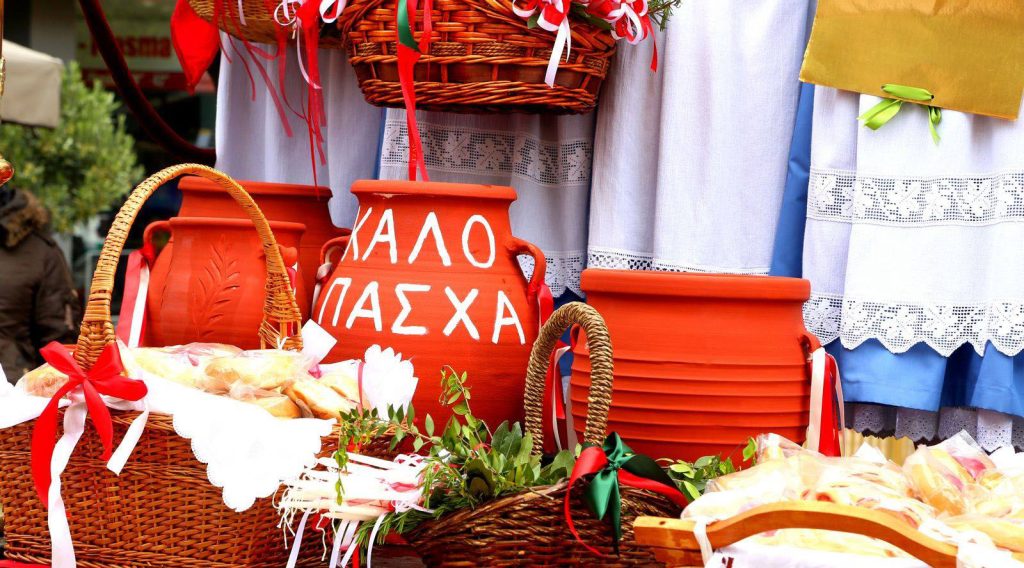
Thinking of visiting Kefalonia in April? Well here are some traditions and customs you’ll come across during the Greek orthodox Easter in Kefalonia.
Easter is the most important and, without a doubt, the most respected celebration in Orthodox Christianity. The spiritual and physical preparations of the 40-day lent period lead up to the Holy Week, in which spiritual and cultural events build up to the day of the Resurrection.
In experiencing this intense religious event, Orthodox Christians everywhere do not limit themselves to the celebrations in church or at home. They organize all types of events, trying above all to highlight their compassionate connection with this divine drama and their jubilation at the Resurrection.

- Palm Sunday
On the eve of Palm Sunday, locals gather in their local churches and prepare small bouquets with Palm leaves in the shape of a cross together with other spring flowers. It’s a beautiful experience to witness the local community coming together for the preparations. On Palm Sunday these will be blessed and shared with all present in this religious ceremony. The small bouquets are taken home, dried, and kept safe until the next year.
2. Painting easter eggs in red
On Holy Thursday, before the 12 Gospels are read out in the evening church ceremony, Greek orthodox boil and dye eggs in red. Red symbolizes Christ’s blood shed on the cross and the egg is a symbol of birth, a new start. On Saturday night once Christ has risen, individuals between themselves tap their eggs in order to crack them, saying “Christ has risen! Indeed he has risen”. The cracking of the eggshell represents Christ’s resurrection from the dead.
(Red dyes can be bought from supermarkets, but many locals collect dark brown seaweed from the sea shores and use that to color the eggs).


- Decorating the epitaph with flowers – after the morning church service has ended on Good Friday, preparations for the decoration of the Epitaphios with spring flowers begin. Tradition has it that only unmarried girls participate in this beautiful decorative event and many locals bring spring flowers from their gardens and surrounding fields. In the center of the Epitaphios, a religious icon, typically consisting of a large embroidered, and often richly adorned cloth bearing a likeness of the dead body of Christ is placed. In the evening the Epitaphios is carried in a procession through the streets of each village accompanied by beautiful hymns.
If you are in Argostoli, the five processions are met at the central square of the island’s capital.
4. Saturday morning – with the first resurrection,
ceramic pots are thrown off balconies, outside St. Spiridon church in Lithostroto highstreet and in Kambana square. The “Botides”, clay jugs, are smashed on the streets with visitors and residents gathering to watch and collect shards as souvenirs. Again the smashing symbolizes Christ’s resurrection from the dead.
5. The holy light and white candles
An important symbolic tradition is the arrival and distribution of the Holy Fire, brought in by airplane from the Church of the Holy Sepulchre in Jerusalem. A large group of individuals with their bikes wait at the airport for the arrival of the Holy Fire and escort it as it’s distributed throughout the island. On the evening of Holy Saturday Greek orthodox go to church with candles or lanterns that will be lit with the Holy Fire and taken back home to bless their houses with holy light.
6. Saturday evening – fireworks and explosives in main squares once the priest sings “Christ has risen” huge firework displays take place all over Kefalonia. In all the villages locals and their communities light up fireworks and firecrackers to display their compassion for Christ’s resurrection.

It’s obvious that if you happen to be visiting Kefalonia during the Easter festivities, you can witness and participate in plenty of events.



